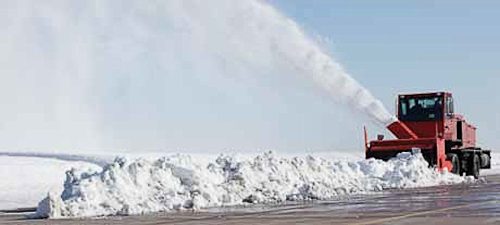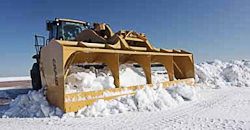
The calendar may say July, but Chris Farmer, director of operations at the Greater Moncton International Airport (GMIA), is thinking about snow and ice – specifically, how to keep it off his runways this winter.
Nestled in the Petitcodiac River Valley of New Brunswick, Canada, GMIA receives a lot of snow, freezing rain and rain mixed with wet snow. With temperatures that dip as low as -13° F, planning for winter becomes a major year-round concern for the airport that moves 550,000 passengers and 24,000 tons of cargo annually.
"We see a lot of snow here," says Farmer, comparing the local weather to Buffalo, NY, where annual snowfall averages 150 inches.
Without proper runway control, winter weather can seriously impact safe airport operations by creating conditions that lead to incidents, accidents and delays. Snow and ice control on the last third of the runway, where pilots decide to take off or abort, is especially important, says Ed Duncan, senior aircraft systems engineer for Continental Airlines.
Realizing this, GMIA has long relied on urea pellets to clear its 6,150-foot and 8,000-foot runways. According to Farmer, the urea performs very well, but its limited temperature range (effective to 23° F) simply doesn't offer enough protection against Moncton's winter extremes. At other airports, environmental bans present the ultimate constraint.

"We needed to grow our technology, so we looked at liquid deicing to expand our runway operations," recounts Farmer. Now the airport uses 10,000 liters of liquid deicer and 100,000 tons of urea every winter.
GMIA began using potassium acetate deicers, but switched to GEN3 deicer from Basic Solutions one year ago. GEN3 Liquid Runway Deicer is among a new generation of non-toxic, biodegradable liquid runway deicers.
|
Facts & Figures
Project:
Location: Products: GEN3 liquid deicer & urea pellets
Annual Usage:
Primary Benefits: |
The airport uses GEN3 to pre-wet urea pellets before spreading them on the runway – a "very effective" practice, according to GMIA's 17-member winter field maintenance team. "They say GEN3 has a lot of staying power, which makes their job easier," says Farmer.
The airport may eventually move to using only bio-based liquid deicer. But the change will likely occur gradually as the airport grows, because liquid deicers cost more, he explains.
Crumbling Corrosion
Although GMIA made the switch to help fight winter conditions, the third-generation liquid deicer also helps combat aircraft corrosion problems associated with potassium acetate and potassium formate deicers. Using "better products" for its airline customers was an added bonus, Farmer explains.
Potassium acetate is the most common liquid deicing product used in North America, says Keith Johnson, president and CEO of deicing manufacturer Cryotech. According to Johnson, potassium acetate and potassium formate deicers have been used effectively for more than 20 years, but problems have surfaced regarding their corrosive nature.
Airlines link the following problems to potassium formate and potassium acetate deicers:
1. Carbon brake oxidation. Over the last 20 years, airlines have moved from steel to carbon brakes to reduce aircraft weight. Contamination from potassium can result in catalytic oxidation and subsequent carbon degradation in aircraft brakes. "Deicer fluid seeps in and works its way into the carbon on a microscopic level," Duncan explains. "As the brakes heat up, it generates a catalytic reaction causing hard carbon disc material to crumble. You cannot predict when this is going to happen. It proceeds quickly and can happen within a few flights."
The corrosion is a serious safety concern, because braking effectiveness is reduced as carbon breaks down, stresses Kelvin Williamson, North American president at Basic Solutions. "Pilots may not get the braking performance they expect," Williamson explains. "If an aircraft does a rejected takeoff, the plane may end up going off the runway."
Brake parts can actually fly off the aircraft and puncture aircraft wings, engines or other areas, he cautions. Carbon disc debris left on runways, taxiways or ramp areas can damage other aircraft.
Airlines have stepped up maintenance intervals to address these problems, he adds, but the extra service comes at a high price – up to $5 million more per year for some airlines. Industrywide estimates, Williamson reports, are as high as $75 million.
2. Cadmium corrosion. Field reports increasingly suggest contact with potassium-based deicers damages aircraft components, especially cadmium-plated ones. Boeing has noted cadmium corrosion on its 737NG aircraft, which has a bigger cutout in the wheel, Duncan points out. It is believed blowback during taxiing sprays deicing fluid onto the plane's cadmium connectors and causes corrosion. As wire bundles become brittle, they begin to arc, adds Williamson.
3. Damage to runway lights, ground support equipment and runway pavement. Potassium acetate and potassium formate corrode these surfaces more often than people realize, says Duncan. "The airfield, their equipment for plowing the runways, the wiring in the inset lanes and taxiways will all benefit from the use of less corrosive materials," Williamson adds.
Greening Ice Removal
The Environmental Protection Agency (EPA) has proposed technology-based effluent standards for discharges from deicing operations at primary commercial airports. According to the EPA website, airports that conduct aircraft deicing operations, have 1,000+ annual jet departures and 10,000+ total annual departures could be required to collect spent aircraft deicing fluid and treat the wastewater. Some airports could be required to reduce the amount of ammonia discharged from urea-based airfield pavement deicers or to use more environmentally friendly products that don't contain urea.
Although this ruling is currently in the reading stage and it only addresses urea use, some say it sets the stage for increased environmental regulations in the future.
 As a result, many airports are taking a closer look at bio-based deicing products- particularly their 80% lower brake carbon oxidization and 75% lower electrical conductivity, says Williamson.Some products also claim lower biological oxygen demand (BOD) and chemical oxygen demand (COD), though Johnson cautions that some bio-based products actually have higher BOD/COD levels than potassium acetate and formate. The products do, however, reduce an airport's carbon footprint because they are wholly or partly composed of renewable agricultural crops such as corn, wheat or sugar cane.
As a result, many airports are taking a closer look at bio-based deicing products- particularly their 80% lower brake carbon oxidization and 75% lower electrical conductivity, says Williamson.Some products also claim lower biological oxygen demand (BOD) and chemical oxygen demand (COD), though Johnson cautions that some bio-based products actually have higher BOD/COD levels than potassium acetate and formate. The products do, however, reduce an airport's carbon footprint because they are wholly or partly composed of renewable agricultural crops such as corn, wheat or sugar cane.
Preferred Products
Because airports have begun asking Continental for advice on which deicers to choose, the company now provides a list of ten products. BX36, GEN3, and BetaFrost are the bio-based options. "These products are non-corrosive (and) inert to carbon brakes and runway surfaces," Duncan says. "We tell airports we know of these products, and we've heard dramatic claims [about reduced corrosion] and the research seems to bear out these claims."
Continental further advises airports to consider the following factors when making their final selections:
1. The product has to melt ice and snow. "The goal is to get a black runway that has some friction," explains Duncan. "We want ice and snow removed, and we want the aircraft to stop. Some of the deadliest airline accidents occur when planes overshoot the runway."
2. It must meet or exceed ever-stricter environmental standards. Regulations will increasingly govern how much deicer can land in the water table. "We need to mitigate the environmental impact of any product we use," says Farmer.
3. Cost. Some of today's bio-based products cost 20% to 30% more than their potassium-based counterparts. However, initial research shows bio-based deicers may dilute more slowly and retain their effectiveness longer, so airports may actually use less product over time. According to Williamson, more statistical evidence is needed to bear out this point.
Come Together
A variety of industry players can play various roles in addressing the corrosion issue. Aircraft manufacturers can study airplane designs to see if better component and brake protection is possible; brake manufacturers could consider changes in design and materials; fluid manufacturers can continue their search for environmentally preferred and less corrosive materials; airlines hold the maintenance interval card; and airports can use deicers that keep runways clear, reduce corrosion and meet EPA requirements.
"There are many stakeholders in airport operations and each places value in different areas," concludes Johnson. "The airlines would like to see products that are better for their materials, and governmental regulations reflect society's want of low environmental impact products. Budget directors would like products with a price that fits their budget, and the applicators want the best performance. We can achieve the greatest benefit as we work together."
|
Bio-based Deicing Options Airports looking for non-toxic, biodegradable deicers have a number of new-generation options at their disposal. Betafrost, from Danisco, is a natural betaine deicer designed to be non-corrosive and inert to carbon brakes and runway surfaces. The product comes in both liquid and solid versions, and is made out of a natural compound extracted from sugar beet molasses. BX36, Cryotech's liquid runway deicer, is made with Dupont Tate and Lyle Susterra Propanediol, which is derived from corn. The product is 75% bio-based and is active at -20° F and below. The product has been shown to reduce electrical conductivity and carbon brake catalytic oxidation. Recent testing at Clemson University showed BX36 also protects runway pavements from damage. GEN3, by Basic Solutions, is currently used by 27 Canadian airports. The product formulation replaces potassium additives with glycerin, a bio-based raw material. Basic Solutions owns the exclusive rights to the product originally developed by the Battelle Memorial Institute. The product is formulated to be effective down to -38° F. |


